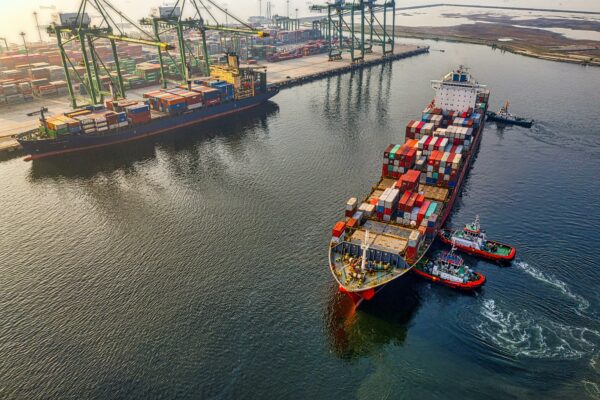Everything Shippers Need to Know About Rates in 2024
Nov 23, 2023
Scroll to find out more
Nov 23, 2023
Scroll to find out more

In many ways, 2023 has been a complete inverse of the factors that drove rates in previous years. Whereas before, events seemed to conspire one by one to keep capacity low, demand high and rates rocketing, this year has seen the opposite. From the Ukraine War to stubborn inflation driving demand, it seems like the global economy can’t catch a break.
For shippers this has been a mixed blessing – yes, rates and down and capacity is fairly reliable. But at the end of the day, most retailers would quite like to be selling more stuff. The constant barrage of supply chain shaking events this year has made planning any long term strategy especially challenging – and with the spot market staying attractively low, there was little incentive to commit.
However, as low demand continued, aggressive blank sailings by carriers to control capacity to and stabilise rates are becoming a norm rather than an exception. With conditions remaining chaotic, here’s what shippers need to know for 2024.
The past year has witnessed a continued decline in rates, despite carriers’ attempts to mitigate this through blanked sailings and General Rate Increases (GRIs). With headline after headline discussing new, precipitous falls, it’s a buyers market, though one where what they’re buying is not always a sure deal.
The cascading of ships from one trade to another and the increase in blank sailings have not been enough to stem this downward trend. After all, there is only so much capacity that carriers can remove, especially on routes such as Asia-North Europe, where colossal vessels that were meant to create economies of scale for carriers now tie their hands on capacity removal.
“There is a commitment from the shipping lines to assure a certain service – a few years ago, shipping lines had committed to have one departure per day from China, so of course if you want to sustain some service, you need to maintain your ship service.” says Anne-Sophie Fribourg.
In practice, this means that while the Transpacific has been more sustainable, with only a 30% drop on the West coast, it’s been a struggle on the East Coast due also to the fact that the Panama Canal has been congested and that there has been more service available on the West Coast.
While this year has seen positive reports in comparison with last year, the big picture remains concerning. Global growth is expected to slow from 3.5% in 2022 to 3.0% in 2023 and further to 2.9% in 2024. This can be seen in the performance of exporter economies – China’s exports fell 8.8% in August compared with a year earlier, their fourth consecutive month of decline.
At the same time, the market is ripe with capacity. “We saw 30 new ships being delivered in 2023, – 24,000 TEU, so the big ones. 2023 and 2024, will see 700 ships being delivered. This represents about 28% of the active fleet.” explains Catia.
In terms of percentage growth for 2023, this represents 9.2% year-on-year. Compared to pre-pandemic periods, that’s a capacity growth of over 15%. The global inactive container ship fleet has also grown significantly, with the number of vessels idle and entering repair yards increasing.
Carriers are doing all they can to safeguard their business models. And it’s not an easy task. Recent moves include:
In starker evidence of the impact of the slow market, Maesrk earlier cut over 10,000 jobs – showing their commitment to stabilising their cost base.
Without concrete knowledge of what the world will throw at global supply chains, the one sure thing we can say for sure is that the industry will keep writing to right itself.
As the end of the year sees more blank sailings and network reshuffling as carriers strive to align their operations with the fluctuating market, this will continue until the economics of carrying freight start to make sense. The bad news is that this means that rates volatility will likely persist, with GRIs fluctuating up until the Chinese New Year. With shippers holding the cards, the challenge of elevating rates with Beneficial Cargo Owners (BCOs) remains daunting for carriers, but expect them to try.
With shippers and carriers working towards 2045 climate neutrality, vessel owners are overhauling their fleets. This included more efficient ships running on biofuel over 13,000 TEUs, new dual ships and the phasing out of old and inefficient vessels and broadly upgrading the current fleet. These movements will also have an impact on service, while also leading to potential higher costs on more expensive fuels.
In this uncertain environment, shippers will be forced to adopt a nuanced approach to their rate strategies. In our conversations with customers, we’re focusing on building diversified rate approaches that balance different rate types and service levels that can provide the agility needed in this volatile market.
While 2024 promises to be another year of uncertainty, with the right tools and support, shippers can still make the most of low rates while keeping goods moving on a reliable schedule.
To find out more about how Zencargo can help you build a reliable strategy, get in touch with our team today.

If you’re looking for a partner who can support you through 2024, and beyond, w...

Last updated: Monday 3pm BST On Friday 19th July, an unprecedented global issue...
